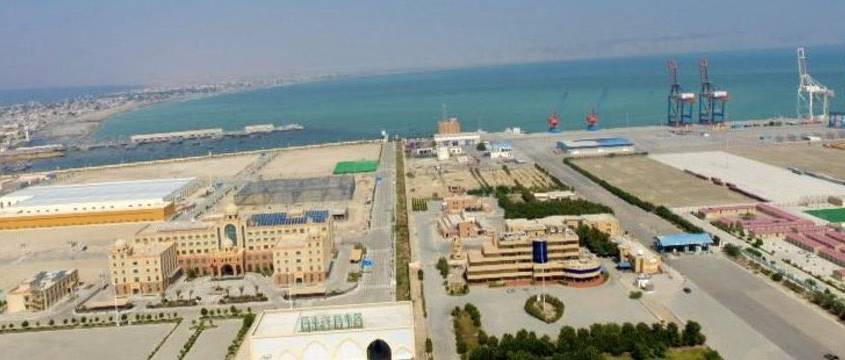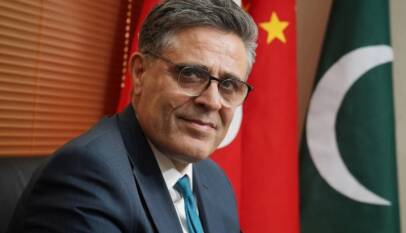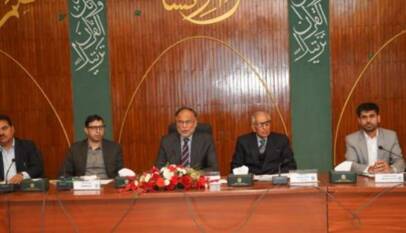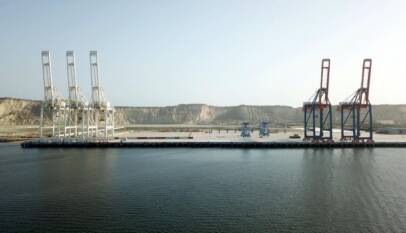Construction work on Gwadar Port Free Zone Phase-I is completed: PES
The Pakistan Economic Survey 2019-20 reported that 3 companies have completed the construction work of Gwadar Port Free Zone Phase-I. The PES noted over 30 enterprises from various sectors including banks, manufacturing, trade and logistics are registered with Gwadar Port Free Zone. Moreover, other development projects related to Gwadar Port and City are in different stages of implementation and approval. Highlighting the strategic significance of the Gwadar Port, the PES reported it would promote connectivity and economic development of the whole region. Meanwhile, Chief Executive Officer of China Overseas Port Holding Company (COPHC) Zhang Baozhong has appreciated the pace of Gwadar Port development. He said Gwadar Port will be highest GDP contributor to its economy by 2030. The Port is becoming a node in international shipping, he added.
ISLAMABAD: Some 18.53 million people will be unemployed in Pakistan in case of a complete shutdown (lockdown) forced by COVID-19, says the Pakistan Economic Survey (PES) released on Thursday.
Quoting the Pakistan Institute of Development Economics (PIDE), it said that in case of limited restrictions, about 1.4 million jobs will be lost, and under moderate restrictions employment loss could reach to 12.3 million. The PES said according to Labour Force Survey 2017-18, unemployment rate is 5.8pc while the total labour force was 65.5 million. That survey said that the highest unemployment (11.56 percent) was prevalent among the age 20-24, indicating youth unemployment.
The PIDE estimates state that the COVID-19 pandemic can have adverse impact on employment generation during the last quarter of 2019-20.
The PES said Pakistan’s population density stands at 265 per kilometer while population growth rate is 2.4 percent. According to the National Institute for Population Studies, population projected for 2019 is 211.17 million. Pakistan is the fifth most populated country in the world. Presently, its population composition is skewed towards working age population. Some 61.4 percent of population is falling in the age group 15-64 while 12.1 percent of population is between the ages of 0-4 years and 22.1 percent is between 5-14 years.
The PES said if this demographic dividend is harnessed and equipped with desired skills to meet domestic and international market requirements, the youth bulge would yield increased industrial productivity and higher foreign remittances.
It said that the government is focusing on various employment generation programmes for youth. Employment is considered as key mechanism through which the benefits of the growth can be trickled down to the vulnerable segments of the society. A large number of young labour force is adding every year.
The PES said Pakistan‘s youth bulge has tremendous energy and talent and the government is making sincere efforts to provide them ample opportunities to harness their potential. Accordingly, Kamyab Jawan Programme and Hunermand Jawan Programme (Skills for All) launched by the government is helping the youth to enhance their skills which will, thus, play a pivotal role in the socio-economic reconstruction of the society.
Meanwhile, the PES said the early harvest projects under the China-Pak Economic Corridor (CPEC) have created more than 85,000 direct jobs for Pakistanis.
It said that nine Special Economic Zones (SEZs) will be established under CPEC portfolio, which will create tremendous job opportunities and technological transformation. Priority will also be given to align technical institutions and training with CPEC related trades and demand of SEZs.
The construction of Free Zone Phase-I has been completed with all infrastructures, including power, water, road, telecommunication, waste treatment, drainage systems are now in operation. More than 30 enterprises from various sectors, such as banks, insurance, financial leasing, hotels, warehouses, fishery products processing, edible oil processing, pipe, furniture manufacturing, electric vehicle assembly, trade and logistics, have already been registered in Gwadar Port Free Zone.
Three companies have completed the construction. The work on the main Free Zone on 2,220 acres of land will be started soon for which China Port Holding Company (COPHC) has completed the master planning and feasibility work.
Since 2013-14, the Gwadar Port Authority (GPA) has been part of all planning and appraisal processes of the CPEC programme. For the early harvest/prioritised phase of the CPEC, following projects related to Gwadar Port and the Port City of Gwadar have been agreed, which are in different stages of project implementation and approval.
The works on the construction of East Bay Expressway with the help of China is in full swing. Eastbay Expressway will be completed during the next financial year, which will connect Gwadar Port with hinterland through M-8 and Makran Coastal Highway.
The PES said that Gwadar Port is about 630km away from Karachi and 120 km from the Iranian border. It is in the process of becoming the Gateway Port for Pakistan and the region and a world-class maritime hub. Gwadar Port, the first deep seaport in Pakistan, is a complement to Karachi Port and Port Qasim in order to stimulate the economic growth of Pakistan in general and Balochistan in particular by better utilizing the available resources of the country.
Gwadar Port is also providing an outlet for land-locked energy-rich Central Asian States, Western China and Afghanistan through transit trade and offering transshipment facilities. In doing so, the development of both Gwadar City and Gwadar Port will make important contributions to the socio-economic development of the Gwadar district and the province of Balochistan while also contributing considerably to the national economy.
June 12, 2020 – One latest, post Covid-19 development in the area of Pak-China economic cooperation, has been revealed by Pakistan’s Advisor for Commerce, Industry, Production and Investment, Abdul Razak Dawood, on June 11. According to Dawood, China has started buying cement from Pakistan and shipments in this regard have started.
This is indeed a breakthrough which may further lead to a massive expansion in Pak-China economic ties.
It may be recalled that Gwadar Port’s contribution towards this mutual cooperation is going on a vertical track as cargo ships operated by China’s Cosco Shipping Holdings have, on some occasions, delivered items related to construction, and sometimes returned to China with seafood.
Mr. Zhang Baozhong, Chief Executive Officer of China Overseas Port Holding Company (COPHC) which operates Gwadar Port and Free Trade Zone, said that Gwadar-related activities are progressing well as more than $ 250 million has been initially spent on port renovation with more investments in the pipeline. In addition, new cranes have been added for unloading cargo along with works on the establishment of a business centre, a desalination plant and sewage disposal systems.
As for the necessity of desalination plants, they are needed to meet the acute scarcity of water and to meet future needs of the locals. Here, annual rainfall is less than four inches. The cost of desalination plant being built on priority basis by COPHC is Rs 1.95 billion. It will provide 5,000 gallons of water per day to people.
Power supply is another important factor. In this area, the construction of a local 300-mw power, imported-coal-fired plant started some months ago, with the original cost of the project being $ 542 million.
While saying that this port is becoming a node in international shipping, Zhang adds, “Of course, the progress is not very fast but it takes time. By 2030, we believe that Gwadar will be a new economic hub of Pakistan and the highest GDP contributor to Pakistan’s economy.”
At Gwadar, a free trade zone was also established in 2015. Nine companies including a Chinese steelmaker and a Pakistani producer of edible oils, signed up at that time to be followed by 30 more firms that came up for Free Zone’s Phase-1, closer to the site of the new airport.
Zhang, however, says that twice that number of companies applied, including some from Europe.
Economists and analysts in Pakistan are of the considered opinion that once the global and regional economy takes off in new form, these foreign companies will enhance their investments in Gwadar projects besides putting them on a fast track.
Last year, Pakistani Prime Minister, Imran Khan visited Gwadar and broke ground on a new airport site. A new contract was also announced that schools and a hospital will be built in addition to other structures.
The name of the hospital being built by China on 68 acres of land, is Pak-China Friendship Hospital and it would cost $ 100 million.
China is also building Pak-China Technical and Vocational Training Institute in Gwadar at the cost of $ 10 million. It will create job opportunities for the locals.
Known for criticism on certain facets of CPEC, Andrew Small, who is also the author of the book ‘The China-Pakistan Axis’, was positive this time about this Pak-China venture, as he says, “the Government of Pakistan led by Prime Minister Imran Khan is trying to complete about $ 20 billion worth of CPEC projects already in the works, mostly power plants.”
Pakistan seeks deeper ties with China in economy, technology: Ambassador Khalil Hashmi
BEIJING (APP) – Pakistan’s Ambassador to China, Khalil Hashmi, highlighted the key t…












